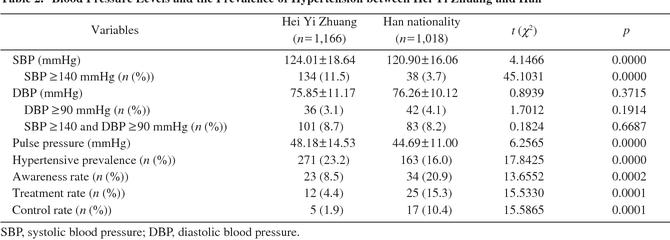Our study was a part of the China Hypertension Survey, 2012–2015, and the investigation started from 2013 to 2015.
The design of the China Hypertension Survey study was published formerly8. In brief, based on the China Hypertension Survey Project protocol, a random sampling group was selected using a stratified and multistage random sampling method. A sample representing the general population aged ≥ 15 years from all 31 provinces in mainland China was obtained. All 31 provinces of mainland China were divided into urban and rural areas to select samples from, using a four-stage random sampling method. The first stage was to choose four urban areas and four rural areas in each province according to the probability proportional to size. In the second stage, two districts or two townships of urban areas or rural areas were selected using a simple random sampling method (SRS), and the third stage was to choose three communities or villages from these districts or townships separately. Then the final stage was to select a given number of participants from each of the 14 sex/age strata (men/women and aged 15 to 24 years, 25 to 34 years, 35 to 44 years, 45 to 54 years, 55 to 64 years, 65 to 74 years, ≥ 75 years) by SRS in the areas selected in the third stage. A total number of 18,000 residents (resided for 6 months or longer) from Baishou town and Sanhuang town, Yongfu; Luoman town and Sandu town, Liujiang; Pingyang town and Sanwu town, Laibin; Datang town and Fumian town, Yulin; Luoxiu town and Luobo town, Guiping; Xinjiang town and Baiji town, Yongning; Luwo town and Luobo town, Wuming; Wenfeng district and Jianshan town, Qinzhou; Bailin town and Fenghuang town Bama were expected to be involved. In the final, 17,100 were enrolled and finished the survey. Each participant was informed thoroughly of the survey's content, and written informed consent was obtained. The Ethics Committee of Fuwai Hospital (Beijing, China) and First Affiliated Hospital of Guangxi Medical University (Guangxi, China) approved the study. This study was strictly in accordance with the Declaration of Helsinki.
All staff members enrolled in the study were thoroughly trained to get a clear perception of the aim of the research and the specific tools or methods to be used. A standardized questionnaire developed by the coordinating center, Fuwai Hospital, was administered by trained staff to collect information on demographic characteristics and social-economic factors.
Height was measured to the nearest 0.1 cm without shoes by the standard right-angle device. Standard measurements for weight and body fat were determined by the Omron body composition monitor (V-body HBF-371, OMRON, Kyoto, Japan). Body Mass Index (BMI) was calculated as weight divided by the square of height (kilogram kg/m2).

Methods to measure BP were the same as our previous study9. Briefly, systolic blood pressure (SBP) and diastolic blood pressure (DBP) were standardly measured three times or more in the seated position with the OMRON Professional Portable Blood Pressure Monitor (HBP-1300, OMRON, Kyoto, Japan), after at least 5 min of rest. In 2% of the present samples, SBP and DBP were measured using both the OMRON device and a mercury sphygmomanometer (Yutu, Shanghai Medical Instruments Co., Ltd., Shanghai, China) for calibration. Measurements were repeated if there was a gap greater than 4 mm Hg between SBP or DBP values with the mercury sphygmomanometer or 10 mm Hg with the oscillometric BP monitor. The mean of the 3 closest values of SBP or DBP was used.
In accordance with the Chinese guidelines for the management of hypertension (2010), HTN was defined as SBP ≥ 140 mm Hg and/or DBP ≥ 90 mm Hg; or any usage of antihypertensive medications within two weeks. Pre-hypertension was defined as SBP among 120–139 mm Hg and/or DBP among 80–89 mm Hg without any usage of antihypertensive medications; Stage 1, 2, and 3 of HTN were defined as SBP among 140–159 mm Hg and/or DBP among 90–99 mm Hg, SBP among 160–179 mm Hg and/or DBP among 100–109 mm Hg, and SBP ≥ 180 mm Hg and/or DBP ≥ 110 mm Hg, individually10. Awareness of HTN was defined as a self-reported history of HTN diagnosed previously by the doctor, treatment of HTN was defined as a self-reported usage of any prescribed antihypertensive medications in the past two weeks, and control was defined as average SBP 11.
Types of antihypertensive medications were classified into calcium channel blockers (CCBs), angiotensin-converting enzyme inhibitors (ACEIs)/angiotensin II receptor blockers (ARBs), β-blockers, diuretics, and others (including traditional Chinese medications, not guideline-recommended medications and medications with unknown components).
Overweight and obese were defined as a BMI between 24.0 and 27.9, and that of 28.0 or more, respectively, following the Chinese adults' guidelines for the prevention and control of overweight and obese12.
Non-smokers were referred to someone who had never smoked before the investigation. Past smokers were referred to someone who had a history of smoking cigarettes but had quit smoking for more than two weeks before the investigation. Current smokers were referred to someone who had a history of smoking cigarettes within two weeks before the study. And the rest of the involving information shares the exact definition as the protocol of this project8.
The Continuous data are presented as the mean ± Standard Deviation (SD); statistical significance between the 2 groups was determined by Student’s t-test, and when among multiple groups, the Kruskal–Wallis H test was applied. Categorical data are presented as frequencies, percentages, and proportions. Chi-squared tests were used to compare differences among categorical variables. To compare with the national epidemiological data, the prevalence, awareness, treatment, control were age-standardized and sex-standardized to the national level, using data from the 2010 Population Census of the People's Republic of China13. To establish models for analyzing multiple risk factors of HTN for Han and Zhuang nationalities, we first used univariate logistic regression to confirm the significant related factors for HTN, variables with a P
